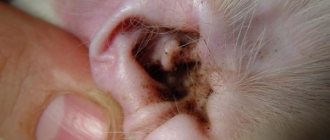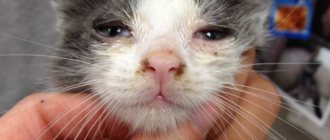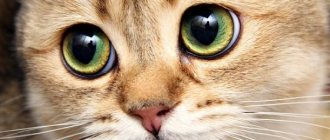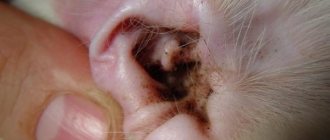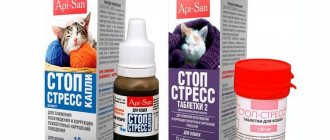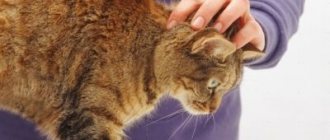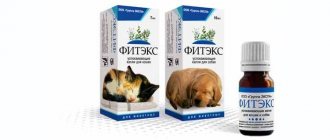6268Pavel
Representatives of the cat family are daily exposed to an increased risk of damage to the mucous membrane of the visual organs, and during play they can become infected with various types of infections, which cause severe irritation. For this reason, it is recommended to regularly instill various medications that can provide protection. But not everyone knows how to put drops in a cat’s eyes, but the effectiveness of the drops depends on knowledge of this procedure. Proper instillation can quickly eliminate irritation and speed up the recovery process.
Features of cat eyes
Compared to other four-legged friends, the cat has the largest eyes relative to body size. This organ has always been the subject of human admiration due to its amazing abilities. In addition, the cat's gaze has a hypnotic effect.
In relation to the body, cats' eyes are larger than human eyes.
Specifics of the visual system:
- Stereoscopic vision. The unique feature is due to the specific location of the eyes, in which the pet is able to view objects at an angle of 205°. This quality gives cats the ability to measure distances between objects and at the same time see what is in front and to the sides.
- Ability to see in low visibility conditions. The pupils of animals are located behind muscles, the principle of which resembles a camera lens. This quality explains the constriction of the pupils in bright light. If there is at least one light source in a dark room, when it hits the cat's eyes it will be reflected from the tapetum. Animals with this choroid layer are able to see in the dark. The eyes of furry pets do not glow in complete darkness. To achieve this effect, a minimum amount of light must be present.
- The presence of a third century. It is a nictitating membrane that protects the cornea from penetration of foreign objects and dust. This formation can completely cover the surface of the eye.
Diagram of the structure of the cat's eye apparatus
How to put drops into a cat's eyes?
A calm animal can be treated independently. Before the procedure, it is advisable to wrap your pet in a thick cloth to avoid injury from claws if the cat gets scared. It is more convenient to treat a nervous and irritable individual with an assistant who will hold it. The procedure is carried out as follows:
- place the cat on your knees with your head away from you and hold its muzzle with one hand;
- Use a swab to clean the eye area from crusts;
- take a dropper with the drug in your free hand;
- pull back the lower eyelid and drop 2-4 drops of medicine into the cat’s eye, unless the instructions indicate a different dose;
- pat the cat and hold it in your arms for 5-7 minutes so that the drug spreads throughout the mucous membrane;
- if necessary, treat the other eye according to the same scheme.
After the procedure, praise the cat and give it a treat.
All information posted on the site is provided in accordance with the User Agreement and is not a direct instruction to action. We strongly recommend that before using any product, you must obtain a face-to-face consultation at an accredited veterinary clinic.
Main cat eye diseases
Every day, furry pets are at risk of visual injury, especially while outdoors. Harmful microorganisms entering the mucous membrane of the eyes cause irritation and contribute to the development of the inflammatory process.
Cats often injure their eyes during active play.
Table 1. Common pathologies
| Disease | Characteristics and symptoms |
| Visible third eyelid | If the nictitating membrane completely or partially covers the cat's eye, this indicates the presence of parasites in the body or a previous injury. The appearance of this symptom is also characteristic of viral diseases and prolonged diarrhea |
| bulging eye | Protrusion of an organ occurs due to its damage or the presence of a neoplasm. Such a symptom is fraught with organ loss |
| Conjunctivitis | Occurs due to penetration of a foreign body, injury to the mucous membrane, exposure to chemicals and diseases of infectious etiology. It is characterized by swelling of one or both eyes and a large amount of purulent discharge. This disease can be transmitted from a sick animal to a healthy one. |
| Retinal pathologies | Caused by degeneration of light-sensitive cells. This process can cause complete or partial loss of vision |
| Keratitis | Inflammation of the ocular cornea occurs against the background of clouding of the mucous membrane and increased tearing |
| Disruptions in the tearing process | Blocked tear duct or excessive fluid production. Causes great discomfort to the animal and leads to a deterioration in the ability to see |
| Glaucoma | An increase in pressure in the eyeball can lead to clouding of the cornea. This pathology can develop into blindness |
| Cataract | A pathology characterized by clouding of the lens. A smoky look is often found in older animals and pets suffering from diabetes. |
Treatment of cataracts in cats
The most popular eye drops for cats
Among all the drugs, there are those that have a fairly good effect and cure the disease in the shortest possible period of time.
Levomycetin
Ear mites in cats: drops, treatment, effective drugs
This drug has antibacterial properties. Levomycetin fights pathologies that arise due to exposure to bacteria. Sometimes the effect of it may be more pronounced than that of antibiotics containing streptomycin or penicillin.
Most often it is used for purulent, follicular or catarrhal conjunctivitis. It is known that drops for conjunctivitis for cats can be very different, including those used by humans, and also include such cat remedies as “Diamond Eyes” or “Iris”.
Barrier
The Barrier lasts about 2 months. It is used to get rid of various types of parasites that can carry a wide variety of viral or bacterial infections.
Note! This drug is for external use only. It is applied to the withers of the animal, while preventing the active substances of the drug from being licked and entering the digestive tract.
Drug Barrier
Drops Tsiprolet
The third veterinary drug belongs to the group of anti-inflammatory and antibacterial agents.
Used to treat ophthalmological diseases of domestic animals. It can also be used in the period after surgery to accelerate healing and restoration of organs and systems. Ciprolex is also placed behind the eyelid when it is necessary to provide a preventive effect and avoid the onset of the disease. This is relevant when the animal is in contact with other representatives of the species and there is a possibility of infection.
The drug is instilled only after removal of accumulated secretions on the mucous membrane. It is used intensively - instillation is carried out up to 4 times a day for 2 weeks.
But it is under no circumstances recommended to use it yourself. This is due to the fact that the dosage will depend on the severity of the disease in the animal. The more intense or advanced the disease, the more drops are applied to the conjunctiva. So, at the initial stage, one drop is applied per eye, while in case of severe manifestations or prolonged absence of treatment, up to 3 drops are applied at a time.
Additional Information! After the drops are poured into the animal's eye, increased tearing will occur. This is due to the fact that the active substances cause a burning sensation and hyperemia of the white area of the eyeball on the mucous membrane of the animal.
There are contraindications to the use of this drug. These include individual intolerance to the components of the drug.
Tobrex
This is an antibiotic. It is actually used to treat human diseases, so it is used quite rarely in cats. But if you need to quickly get rid of a complex problem, then Tobrex will provide a pronounced positive result in a short period of time. The best way to use it is:
- with inflammation of the iris or edge of the eyelids;
- when inflammation occurs on the cornea.
Lachrikan
Lacrican is used to cure blepharitis or purulent conjunctivitis in a cat, which is caused by bacteria. The active components of the drug have an anti-inflammatory, antimicrobial, enveloping and local anesthetic effect.
If we talk about the dangers of using this substance, it is worth noting that it belongs to the fourth class. And this indicates that it does not cause toxic poisoning of the body, as well as irritation in the area where it is applied. Does not increase sensitizing sensation. As a result, it can be recommended as eye drops for kittens.
Just like with all other drugs, before applying the drops under the eyelid, you should remove all the secretions that have accumulated in the eye area by this time. And only then instill the drug. Lacrican is applied 2 to 3 times a day. The duration of treatment usually ranges from 1 week to 10 days. If the drug has an effect, but does not completely cure the disease, then you need to take a break for 7 days. And then they repeat the same course, which causes a more lasting effect and relief from the remaining symptoms.
Leopard
The drug Bars belongs to the group of substances that have antibacterial effects and is used strictly locally. Among the main reasons for its introduction are the following:
- purulent conjunctivitis in acute or chronic form;
- eye injury, which in the long term may lead to the development of any disease associated with the development of bacteria or infections in the affected area. In this case, Bars is used as a prophylactic agent.
The principle of application includes the same steps as for other drugs:
- treatment and removal of purulent discharge with a soaked cotton swab to cleanse the mucous membrane;
- administration of the drug into the conjunctiva according to the established treatment regimen - these data are in the instructions for the drug. But, despite this, the frequency and number of instilled drops should be prescribed by a veterinarian, depending on how intense the infection is in the animal and how long the disease lasts.
- for prophylactic purposes, the drug is used once a day; It is necessary to carry out instillation for 10-15 days - only in this way is a clinical effect achieved, and the animal is completely relieved of health problems and symptoms.
Drops Bars
The dosage of the drug Bars is 1 or 2 drops in each eye.
Important! This medicine has no side effects. This is what allows it to be used not only by adult animals, but also by small kittens.
The drug is stored at room temperature.
Note! The validity period is very short. A closed bottle lasts only 12 months. Therefore, before purchasing, you need to make sure that the expiration dates are within acceptable limits.
Once the bottle of Bars drops is opened, it must be used within 1 month. After this, the medicine loses its healing properties and is not suitable for further use.
Breed predisposition to stagnation of tear fluid
Representatives of breeds characterized by a flattened muzzle often suffer from inflammatory eye pathologies.
A similar design of the front part of the skull in Scottish Folds, British, Exotic and Persian cats helps to delay the flow of tear fluid into the nasal cavity. This quality is explained by the artificial breeding of breeds.
Scottish Fold cats are prone to developing conjunctivitis.
The specific structure of the muzzle causes stagnation of tears in the corners of the eyes, which makes animals sensitive to various eye diseases, especially conjunctivitis.
Exotic animals have the flattest faces and are more susceptible to eye pathologies than others.
Eye examination
The animal should have wide open and clear eyes with no obvious discharge. Small brown spots in the corners in the morning are normal. This is a dried secretion of the lacrimal glands, which the pet independently removes during hygiene procedures. If the condition of the eyeball is in doubt, a thorough examination should be done in bright light.
Signs of healthy eyeballs:
- bright and clean mucous membranes;
- pupils of the same size;
- the iris is free of hemorrhages;
- uniform eye opening;
- absence of purulent masses and lacrimation with a few breed exceptions;
- the third eyelid is hidden.
In addition to examining the eyes, it is necessary to inspect the inside of the eyelid. To do this, you need to carefully lift your pet's eyelid up with your thumb. In a healthy cat it is pink. White or red are a manifestation of pathology.
Examine the animal carefully
Dangerous symptoms
There are many signs of the presence of pathological processes in the visual system. One of the most obvious is the lack of reaction to light. Normally, a cat's pupils constrict when exposed to bright light. This protective mechanism reduces the impact of light on the sensitive eye. If this does not happen, the animal should be examined by a veterinarian.
The brighter the light, the smaller the pupil
Alarming symptoms:
- lacrimation;
- purulent discharge;
- visible third eyelid;
- retraction of the eyeballs into the sockets;
- swelling of the eyelids;
- scabs in the corners;
- the appearance of spots on the retina;
- squinting, closing or protruding eyes;
- traces of tears on the muzzle;
- change in eye structure or color;
- behavioral failures.
If any of the listed manifestations are detected, the animal should be shown to a specialist.
Excessive attention to the animal's eyes indicates the presence of eye disease.
Body language also signals possible pathologies. If your pet often squints or paws at areas adjacent to its eyes, consult a doctor.
Features of the correct use of drops
In order to properly place drops into your cat's eyes, you need to consider some features of using these medications. They are required to be used if there is a pathological process in the pet’s eyes, for example, when they become very red and begin to fester, while the eyelids become very merged and cannot open normally. All these symptoms can be caused by various reasons, but it is important to immediately provide first aid to your pet - wash the eyes and then contact a veterinarian.
© shutterstock
At your appointment, your veterinarian will be able to explain in detail how to apply the drops correctly. He will talk about the features of using these products, as well as further care. If everything is done correctly, the animal will not even feel discomfort during the procedure.
Tips for using drops for cats
In order to properly apply eye drops to cats, the following recommendations should be followed::
- the whole procedure should be carried out as naturally as possible, for this reason, create all the conditions so that the cat feels calm - you can stroke it, caress it, talk to it affectionately;
- After this, it is recommended to carry out preparatory cleaning. First, one eyeball of the animal must be rinsed with clean warm water using a cotton pad or pipette, and after that you can begin to rinse the other;
- It is recommended that the prescribed ointment or eye drops be applied or instilled into clean eyes for the cat. Do not open the tube until the cat’s visual organs are completely washed;
- After this, you need to take a tube of liquid in your right hand and pull your eyelid down with your left. The required number of drops should be dropped into the formed gap using a pipette. Then you also need to drip into the second;
- You must make sure that the medicine gets into the eye and not onto the fur;
- After instillation, you need to hold your pet as tightly as possible. The point is that at this moment they feel a strong burning sensation, itching, and even pain, and it is not at all surprising that the cat can become aggressive and restless;
- It is advisable to gently massage the eyelid so that the medicine is absorbed faster. But how to do this, you can watch a video with a detailed massage procedure.
After the entire procedure, the animal can be safely released into the wild. In order for your pet to bear it more easily and be able to quickly forget all the unpleasant sensations, you can give him his favorite treat as compensation.
If your veterinarian recommends using two medications at once, you should never use them at the same time. They are buried at intervals of 15-20 minutes. If different medications are used at the same time, they may not have the desired effect.
Care Tips
The eye structure of felines and humans has many similarities. Care, treatment and prevention of eye diseases in furry pets are similar to those in humans.
Due to the common structure of the eyes, care procedures in humans and cats are almost identical
Practical recommendations:
- All procedures should be carried out with disinfected hands.
- Before any manipulation, remove discharge from the corners of the organ with damp cotton pads. The direction of movement is from the outer corner to the inner one.
- You can wash the eyes of a healthy animal with saline solution or chamomile decoction. A boric acid solution and eye antiseptics are suitable for a sick pet. All drugs used must be warm.
Chamomile decoction is considered an excellent disinfectant
- If long hairs that are not vibris grow in the area around the eyes, they should be trimmed.
- Any medications should be used only as prescribed by a veterinarian.
- Cooled brewing of strong tea has a good calming effect.
It is not advisable to give your pet drops intended for people.
Persian cats require special eye care
How to administer eye drops for cats
Proper use of eye medications is essential to your cat's speedy recovery. Make sure you wash your hands before and after applying the medicine to avoid contamination and prevent the spread of infection. Before use, always read the product label and instructions.
What are some tips for using eye drops on a cat?
Here are some tips to make administering eye drops to your cat easier for both of you:
- Gently clean the eye area with warm water and a clean cloth. This may calm your cat and prepare him for the drug.
- Hold the tube using the thumb and index finger of your dominant hand and point it downwards. You can gently rest your hand with the tube on the top of your cat's head, this will help make it more stable.
- Using the thumb of your free hand, gently pull down your lower eyelid. Place the remaining fingers of your hand under the cat's jaw. The lower eyelid will be the site of application of the drug.
- Keep the tube close to your eye, but make sure you don't touch the surface of your eye with it!
- Apply the required number of drops directly to the eyeball and then release your cat's head.
The cat will begin to blink, and the warmth from the eyeball will help the drug spread over the surface of the eye faster. Droplets of the drug may accumulate in the corners of the eyes after application, this is normal.
After application, cats tend to blink frequently and rub their eyes with their paws. If these reactions persist or if the eye becomes more sore or red after the drug, consult your veterinarian.
What to do if the cat is restless and cannot sit still to apply the drug?
- If you apply the medication yourself, you can place your cat on your lap. In addition, in order to restrain your cat, you can wrap it in a warm blanket or towel, leaving only its head free.
- The first few uses of the drug, or if your cat's eye is painful, you may want to have someone help you hold the wrapped cat while you instill the drug.
- Praise your cat throughout the procedure, and be sure to offer her a treat afterwards.
If you have any questions, please contact your veterinarian. If your cat's eyes become very inflamed or painful, or if her condition begins to worsen, do not wait and take her to the vet immediately.
How to put drops in a cat's eyes
An important aspect of treatment is the proper use of medications. Correct execution increases the effectiveness of the procedure and speeds up the recovery process.
Drops are prescribed for the development of pathological processes in the eyes of an animal. Indications include redness of the mucous membrane, purulent discharge, and sticking of the eyelids.
Basic rules of procedure:
- Remove the drug from the cat's field of vision.
- Place your pet on your lap.
- Calm by stroking the chin.
- Clean the surface of the eyelids using a cotton swab soaked in warm water or chamomile infusion.
- Rinse the mucous membrane by dripping a warm cleansing solution from a distance of 1 cm from the surface of the eye. Position the cat's head so that the liquid flows freely from the outer corner of the eye to the inner one. Remove any remaining moisture from the treated area with a napkin without touching the mucous membrane.
- Take the tube of liquid in your right hand, and gently pull your eyelid down with your left hand. Squeeze the required amount of medicine into the gap formed.
- Gently massage the eyelid for better absorption of the medication.
- Make sure that the liquid gets into the eye and does not remain on the fur.
- Spend a few extra minutes with your pet to prevent eyeballs from scratching.
- Reward the animal with its favorite treat.
Apply eye drops while holding your pet on your lap.
It is advisable to talk to the animal during the procedure. The sound of the voice will have a calming effect on him.
If the veterinarian has prescribed 2 types of drops, the drugs should be instilled with a 15-minute interval. Simultaneous administration will not give the desired result.
Sequence of eye drops for a cat
Indications for eye treatment are pathological processes. For example, this is redness of the mucous membrane of the organ of vision, purulent discharge and gluing of the eyelids.
Before instilling medication into the eyes, you need to gently and carefully wipe the area around the eyes with swabs soaked in warm water to remove pus and other contaminants. Instead of water, you can use any warm tea or chamomile flower decoction.
Procedure:
- Rinse the mucous membranes of one eye first, and then the other with a cleansing solution. Remove wet residue.
- Open the tube with the pharmaceutical preparation.
- Slightly pull the eyelid down and squeeze 2-3 drops of the product into the resulting gap. During the procedure, you need to talk to the animal gently, this will calm him down.
- Massage the eyelid for 5-7 seconds for the best distribution of the medicine. The liquid should not leak onto the wool.
- Repeat the manipulation with the second eye. Do not let go of the animal for 2-3 minutes so that it does not scratch the eyeball.
The pet will feel itching or burning after the procedure. Sometimes the cat may feel severe pain. At this point she will become restless or even aggressive.
The animal needs to be rewarded with its favorite treat.
How to properly apply eye drops to a kitten?
The rules for administering medications to adult animals and children are no different. As an alternative to the previous method, you can place your pet in the bathtub and wrap it in a towel, holding it with your left hand. It is desirable that it closes in the nape area. The bent elbow lifts the cat's chin, and the right hand buries the drops. This method is suitable for shy and aggressive animals.
Example of eye drops
Eye treatment for kittens
Therapy of eye diseases mainly involves local treatment using drops. In veterinary ophthalmology, there are many drugs that are successfully used to relieve pathological processes.
All products are classified according to the main active component:
- antiseptic;
- antibiotic;
- immunomodulator.
Experts have developed several groups of medications for the treatment of eye pathologies
The first 2 categories are used for pathologies of bacterial etiology. The third group is used in combination with other drugs in the treatment of viral infections.
Table 2. Effective drugs for the treatment of eye disease
| Group | Description | Names of drugs |
| Bactericidal | Antiseptic drops that prevent the formation of pus. Effective in the early stages of pathology development | "Lakrikan", "Ophthalmosan" |
| Antibacterial | Used for the development of local bacterial infection | “Tsiprovet”, “Dekta-2”, “Iris”, “Desacid”, “Lakrimin” |
| Immunomodulatory | Indispensable for pathologies of viral etiology and advanced inflammatory processes | "Maksidin", "Anandin" |
The most effective method to prevent the development of eye diseases is to regularly examine your pet by a veterinary ophthalmologist. In addition, it is necessary to adhere to the vaccination schedule and periodically examine the animal yourself. In the absence of timely treatment of pathologies, serious disruptions in the visual system and even blindness are possible.
